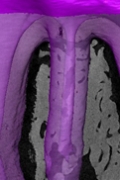Trabecular bone is an intricate 3D network of struts and plates. We developed a parameter that measured the angle between two connected trabeculae – the Inter-Trabecular Angle (ITA). An analysis of the inter-trabecular angles (ITAs) of the 3D fabric of the trabecular bone of the human proximal femur reveals the presence of highly conserved underlying topological motifs that include most significantly nodes with 3, 4 and 5 emanating edges in proportions of 12:4:1.





